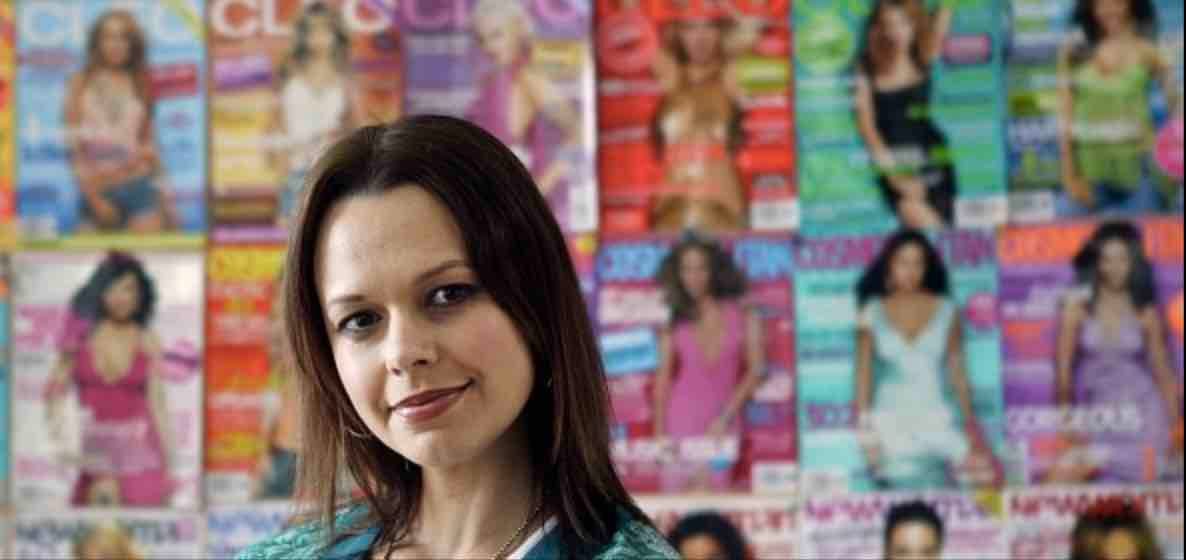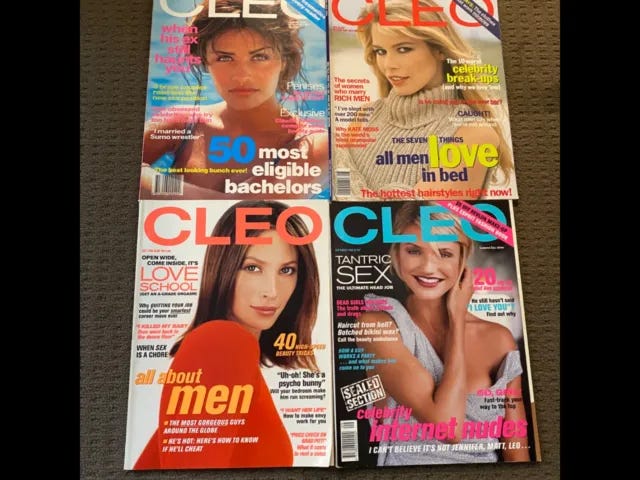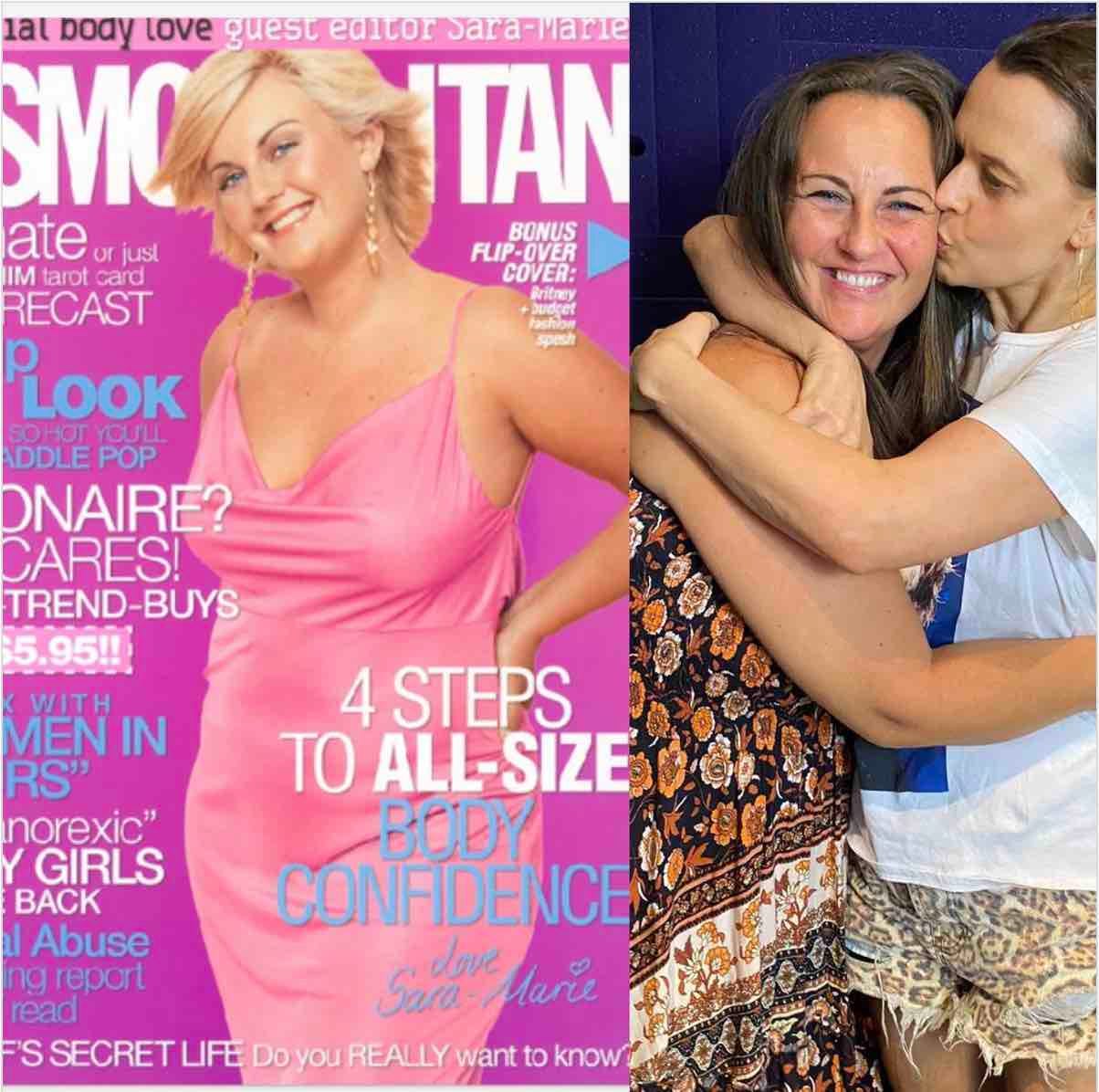As we get closer to the launch of Strife., the TV series inspired by my memoir Work Strife Balance, I’m going to share a few memories from the years of my career that are loosely reflected on the show. Leaving magazines, taking a job that turned out to be an utter disaster and starting Mamamia without a clue in the world how to run a business.
I’m nervous AF about Strife launching, both as one of the Executive Producers and as the person whose story inspired it. Hold me.
I work with a lot of young women who have little or no memory of magazines and the role they played for Gen X women and Milennials.
Their interest in what it was like back then and how Mamamia started has sparked some reflection about those times. The past 15 years of building up this business with my husband Jason from a single laptop and a single idea: to make a website where women felt seen, heard and understood and to make the world better for women in that way, has been the most exhilerating, stressful time of my life.
Over the next few weeks I’m going to share some of the behind-the-scenes of my career and of the show. Here’s the first instalment………
In the 15 years I’d worked in magazines, I'd always based my editorial decisions on my feelings as a reader, not as an editor. This is how you gather your most valuable insights; my advocacy around body image began that way. As a consumer of magazines myself, I knew how dispirited I felt to see nobody who looked like me or any woman I knew. As a woman and a feminist, I thought this was appalling. As a businesswoman (which magazine editors are, don’t let the rest of the media mislead you into thinking otherwise with their patronising portrayal of that job), I thought it was a baffling one. Why make your readers feel bad about themselves after engaging with your brand? How is that good for business?
You can argue convincingly that many marketers do this deliberately precisely because it is good for business. In her iconic book, The Beauty Myth, Naomi Wolf first floated the theory in 1990 that companies marketing products and services to women use our insecurity to prompt us to buy. Create a problem then market a solution. Women's magazines have always done this.
Cover lines like...
IS YOUR HAIRCUT MAKING YOU LOOK OLD?
DOES HE THINK YOUR VAGINA IS TOO BIG?
7 SIGNS HE'S ABOUT TO BREAK UP WITH YOU
DOES YOUR SEXUAL HISTORY MAKE YOU A SLUT?
HOW TO DROP A DRESS SIZE BY SATURDAY
While masquerading as sisterly and helpful, these kinds of cover lines deliberately bought into damaging and sexist tropes that pushed our insecurity buttons and made us want to buy the magazine so we could learn how to avoid being old/loose/dumped/slutty.
Early in my career, I no doubt helped write those kind of coverlines, by the way. I always fought against the diets but it wasn't until I became an editor myself that I realised the impact of those other messages and changed tack.
It was around the mid-90s when I realised it. Women no longer wanted to be told how defective we were. So when I became an editor at Cosmo in 1996, I tried a different approach both with the stories and the images we published. The word ‘empowering’ didn’t exist back then, but that’s broadly what I tried to achieve with more positive articles, a less patronising tone and more diverse models.
At first, I made some colossal mistakes. First, I abolished the sex and relationships content because I thought if I wasn’t interested in reading it anymore, nobody else was either. I’d recently met Jason, was embedded in monogamy and had been reading/writing/editing sex and relationship stories for at least 10 years so stories about dating and orgasms felt retro and repetitive to me. Surely there was nothing left to say...
My boss, Pat Ingram blanched visibly when I proudly announced my idea to her but then she did something smart: she said "Okay, try it."
This is a boss lesson I’ve repeated many times with my own team. If someone you rate has an idea they passionately believe in, I challenge her on it. I make her fight for it. It forces her to think it through more thoroughly and it filters out the ideas that aren't robust enough; the ones with gaping holes. If she keeps coming back and can argue her case convincingly, so long as it’s not going to irreparably damage the business, I will usually let her try.
On the upside, it might just work. I’ve been on both sides of that.
My Australian bosses were bemused when I wanted to put Big Brother star, Sarah-Marie on the cover of Cosmo but my American bosses were horrified.
By the time they saw it though, the cover had already been printed and it was too late. It was one of the best-selling issues of Cosmo I ever did.
As a boss now, I love nothing more than being proven wrong by someone who has an idea or an approach I haven't thought of. Genuinely. On the slightly less upside, it won’t work but she will learn from it in a way she never would if I'd said a flat no. Because if you simply overrule the idea, they will die believing it would have worked if only you hadn’t stopped them. No lesson there.
And so it came to pass with my genius idea to ditch sex and relationships from Cosmo in the mid 90s. The minute the first week of circulation figures came in, I realised how badly I’d f**ked up. Of course, Cosmo needed to publish sex and relationship articles. They’re the foundation of Cosmo and I was a fool to think I could just reinvent one of the world’s most successful brands.
It was an effective wake-up call. I was in a long-term relationship, was well-established in my career, and felt confident enough to flick past stories about giving better blow jobs. I had a mortgage and wasn’t exactly living the Cosmo-girl lifestyle. I was also, aged 24, at the older end of the Cosmo demographic, and I was about to be pregnant with my first child which is about as un-Cosmo as you can get. It was yet another of the many lessons my mentors, like Pat and Lisa Wilkinson, have taught me about being a leader, a content creator and a boss.
If I was behaving in a certain way as a consumer it meant other women were doing the same thing and the mainstream would be following closely behind.
I knew I was disillusioned with traditional media. I knew I was frustrated by the way my beloved glossy magazines were published monthly while every woman I knew was living her life in increments of minutes and seconds.
And the three-month production time meant content created in November wasn’t published until February the following year. No brand catering to young women could possibly remain relevant when it was months out of date by the time it hit newsstands. As the news cycle sped up and we became hungrier for more information, faster and for free, the magazine business model that relied on paid sales of a printed product appeared to me to be glaringly, fundamentally flawed.
How could media brands aimed at women possibly remain viable given the physical and practical constraints of print?
By the time I exited magazines in 2005 when I was pregnant with my second child, I had become exasperated and exhausted after years spent trying to convince my middle-aged male magazine bosses that Armageddon was coming for our industry. The mass migration of young women towards digital media had begun and would soon become a stampede. Despite my repeated exhortations in the early 2000s that we needed to pivot to digital, the online presence of magazines across the industry remained woeful. My bosses were adamant: we were a magazine company. The Internet was a fad.
What they failed to understand was that those magazines - beloved by generations of women - iconic mastheads like Dolly and Cleo and Cosmo - were brands. They weren't just printed products. And in not recognising that, they burned decades of brand equity built by the hundreds of talented women who had worked on those brands since they were launched decades earlier. All of them are gone now.
And that's obviously bittersweet for me because like millions of Australian women and girls, those brands meant so much to me.
As a consumer and an editor, I knew unequivocally the future of women’s media was online and I wanted to be part of it.
After my disastrous seven month detour via commercial TV, I turned my mind to how I could do something new. Something online.
This is an edited excerpt from my memoir Work Strife Balance, which is the inspiration behind the new TV series Strife.
If you want more behind-the-scenes Strife content? Check out these stories:
Mia Freedman answers the 20 most common questions about Strife, the show inspired by Mamamia.
Inspiration behind TV show Strife: How I built a media company from my lounge room.
MIA FREEDMAN: I'm producing a TV show based on my book, Work Strife Balance.
The full cast for the upcoming Binge series Strife, starring Asher Keddie, has been announced.
Watch the first trailer for Strife, the new TV show inspired by the story of Mamamia.
EXCLUSIVE: Take a look at the first extended clip of Strife, the new TV series inspired by Mamamia.
If someone sent this to you and you’d like to get it direct from me to your inbox next time, sign up below - it’s free







I was a magazine fiend! I’ve really only stopped buying them in the last 2 years or so. I loved nothing more than sitting with a pile of magazines & flicking through them. I’ve still got some stored on top of my bookshelves. Why? I don’t actually know but they’ll stay there for a while longer. I only just got rid of my CD’s & haven’t used those in about 10 years!
Geez Mia. I’m a boomer too born in 1960. My whole life was magazines - Dolly, the heyday of Cleo, Cosmo through to Grazia and now online. Loved them!